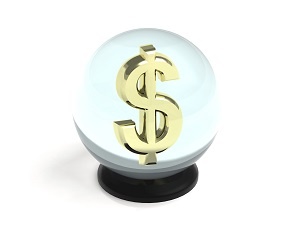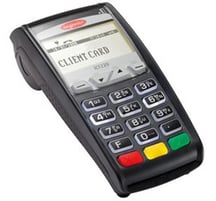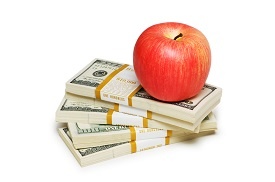 Last January, there was no shortage of payments predictions for the year 2015. For example, remember these?
Last January, there was no shortage of payments predictions for the year 2015. For example, remember these?
- Apps for everything
- EMV chip cards
- Electronic wallet
- Mobile payments
- Apple Pay
- Bitcoin
- Faster Payments
- eCommerce
- P2P payments
- Cashless society
What Happened?
Most of these predictions fell far short of the mark.
Apps for Everything
Yes, there are apps for everything, almost two million apps for iOS, Android and Windows. If you built a successful one, you were already spending your residual payments last year, but not so fast. It turns out that most consumers only download a few dozen, and of those, only use 5-10 on a regular basis. Grade: 7 out of 10.
EMV Chip Cards
 The EMV chip card, a 20-year -old technology, was mandated for many merchants taking payments at the point of sale effective last October. This rollout could be characterized charitably as “not ready for prime time.” Many merchants still do not have an EMV-capable terminal, or they have one that is not powered up. In addition, many consumers have not yet received EMV credit cards or EMV debit cards.
The EMV chip card, a 20-year -old technology, was mandated for many merchants taking payments at the point of sale effective last October. This rollout could be characterized charitably as “not ready for prime time.” Many merchants still do not have an EMV-capable terminal, or they have one that is not powered up. In addition, many consumers have not yet received EMV credit cards or EMV debit cards.
This “value add” from the card brands caught many merchants by surprise. With separate certifications from each card brand, it’s a time consuming and expensive process for companies with multiple locations. It will be another year or more before this rollout is completed while merchants such as restaurants may ignore it altogether. Grade: 5 out of 10.
Electronic Wallet
The electronic wallet has been a non-starter up to now. A consortium of 40 large retail brands called Merchant Customer Exchange (MCX) has a wallet called Current C, but it has had limited success. Instead, an interesting thing has happened which may explain why.
Large retailers have focused on deploying their own proprietary store cards instead of a wallet solution and have been very successful. At Kohl's, their proprietary card commands 58% of sales! It’s 48% at Macy’s, 40% at Nordstrom, 21% at Target, and at mega retailer Best Buy, it’s fully 20% of sales (report by Ryan Douglas at 1st Annapolis Consulting). Score: proprietary cards: 9 out of 10; electronic wallet: 5 out of 10.
Mobile Payments
Mobile payments have been a success. But something unexpected happened — “malware risk.” Research Director Julie Conroy of Aite consulting firm said, “As the mobile channel continues to grow, criminals are following the money.”
Some Trojan apps masquerade as common popular applications and stay incognito after running for the first time. “They have the ability to phish for and harvest authentication credentials when specified banking apps are launched,” stated a report by FireEye. Android malware presents a significant threat to targeted entities and mobile device users. Grade: mobile apps: 8 out of 10; mobile app security: 5 out of 10.
Apple Pay
 Apple Pay was one of the most publicized events of last year, but in terms of “signal-to-noise ratio,” it was a failure. To state the obvious, only a small percentage of consumers can actually use it (they need the right device and the merchant needs a working NFC terminal). If you work the numbers, this is a minuscule percentage of the population. The number of transactions processed on ApplePay is likewise insignificant. I think Apple was very smart here in two of their decisions: (1) not disrupting the Visa-MC rails and getting the networks to pay a 15 b.p. fee for “fraud protection,” and (2) for reviving NFC (near field communication) which was previously on life support. I would not bet against Apple in this space; they just haven’t gotten traction yet. But I predict they will. Grade: 6 out of 10.
Apple Pay was one of the most publicized events of last year, but in terms of “signal-to-noise ratio,” it was a failure. To state the obvious, only a small percentage of consumers can actually use it (they need the right device and the merchant needs a working NFC terminal). If you work the numbers, this is a minuscule percentage of the population. The number of transactions processed on ApplePay is likewise insignificant. I think Apple was very smart here in two of their decisions: (1) not disrupting the Visa-MC rails and getting the networks to pay a 15 b.p. fee for “fraud protection,” and (2) for reviving NFC (near field communication) which was previously on life support. I would not bet against Apple in this space; they just haven’t gotten traction yet. But I predict they will. Grade: 6 out of 10.
Bitcoin
Bitcoin was probably the most publicized innovation in FinTech last year and unquestionably the biggest failure. It didn’t help that cyber criminals quickly seized on Bitcoin as the perfect coinage for laundering financial transactions, and some pretty shady characters surfaced. But the real issue is readily apparent to anyone who took “money and banking” in college. Nobody in their right mind thought for a second that the Federal Reserve was going to abdicate the creation of money and the attendant effects on monetary policy to any other entity, particularly an anonymous one. Now people are quick to separate Bitcoin from the Blockchain, but last year it was pretty difficult to even find someone who could succinctly and logically explain how the two worked in less than 100 words. Grade: 2 out of 10.
Faster Payments
Of all the hype and drama in the FinTech space, nothing exceeded the pronouncements surrounding the urgency for faster payments. A typical breathless statement is: “Unlike many developed and developing countries, the US does not have a real time payments network.” This is nonsense. There are four major money transmitters out there (Western Union, Moneygram, RIA and Transmex). There is a proliferation of providers such as Green Dot that can load a payment card for instant use. And then there is the Federal Reserve wire transfer system for when you absolutely have to get the money there today. If you have ever worked in a wire room, you will be familiar with the extraordinary level of security, fact checking, sign-offs and authorizations that accompany a wire transfer which is the absolute riskiest product the bank has to offer.
Cries for “faster payments” seem to have emanated from a payments blog — in my 30 years of cash management work, I have never heard a business state a need for “faster payments.” In fact, they are typically looking for ways to stretch out their accounts payable. On the accounts receivable side, all checks clear the next business day. There is no need to get the money one day sooner, particularly when the Fed Funds rate is close to zero. Who’s kidding who here? Grade: Hype: 9 out of 10; Reality: 5 out of 10.
eCommerce
 The need for e-commerce is as appealing as motherhood and apple pie, but the reality is something else. Only 7% of retail sales transactions were done last year in e-commerce. Logic tells us to focus on the other 93%. Writer Jeff Schneble has said that for e-commerce to succeed it has to do three things: help the consumer find and experience products, enhance the magic of the retail experience, and have a compelling ROI for the retailer. There is no widespread solution yet. Grade: 6 out of 10.
The need for e-commerce is as appealing as motherhood and apple pie, but the reality is something else. Only 7% of retail sales transactions were done last year in e-commerce. Logic tells us to focus on the other 93%. Writer Jeff Schneble has said that for e-commerce to succeed it has to do three things: help the consumer find and experience products, enhance the magic of the retail experience, and have a compelling ROI for the retailer. There is no widespread solution yet. Grade: 6 out of 10.
P2P Payments
Only slightly less hype has been devoted to the area of P2P payments. Today, most person-to-person payments are made in very effective and easy-to-use mechanisms: cash and check. About a third of P2P payments are for rent. Perhaps another 15% is to pay “shared bills” (e.g. a restaurant tab). Gifts are about 7%. The rest is used for vacation/travel, childcare and tickets/entertainment. I don’t know about you, but I have found very little need to pay another person with anything but a check. Moreover, I cannot imagine a consumer paying a premium to pay a low dollar payment (e.g. $20) to a friend the same day, and it is even harder to imagine a realistic revenue model for the processor of such a payment. Grade: 5 out of 10.
Cashless Society
Another overhyped phrase is the cashless society. Here’s what really happened. A recent study by Cardtronics, a retailer ATM network, shows that consumers use cash far more than any other payment method to pay other people, and cash also remains the leading payment method in many merchant sectors.
Tom Pierce, chief marketing officer at Cardtronics, said: “In a competitive payments environment, cash is a predominant payment form, and sits atop multiple spending categories.” Their survey showed that 78% of respondents use cash to pay someone back, 49% use cash to pay a small business, and 53% use cash in a restaurant. In fact, 70% of Americans buy inexpensive items with cash. The Cardtronics survey even showed that 45% of young adults said they are more likely to pay with cash today than they were a few years ago. Pierce concludes, “There is a myth that Millennials have abandoned cash in favor of mobile and other digital payments. It’s simply not true.” Grade: 4 out of 10.
Check Writing
There is another myth out there — that people are abandoning checks for other forms of payment. Consumers use their debit card for small dollar purchases at POS instead of writing a check, but check volume is attriting at about 2% a year, not the 10–20% that some industry “experts” have been predicting. Yes, consumers are not writing checks for recurring same dollar payments as they used to do; they are done with automated clearing house (ACH) debit (think life insurance, mortgage, etc.).
But checks are still used for high-dollar purchases (more than a few hundred dollars). Nobody buys a car with a credit card, and merchants don’t like to take them for a high dollar transaction, say over a few thousand dollars. Virtually all B2B payments are made with a check. Even the four million QuickBooks merchants pay with checks because that is how QuickBooks is set up.
So if you are a car dealer, auto aftermarket merchant, veterinarian, funeral home or building supply dealer, to name a few markets, you are going to see just as many checks as ever. And remember, even if the consumer forgot his or her checkbook, we can create a digital check for them so you do not lose an important piece of business. So if you were going to grade checks as a safe, secure payment method with immediate finality of payment and the full protection of the Uniform Commercial Code, I would grade them 10 out of 10!



